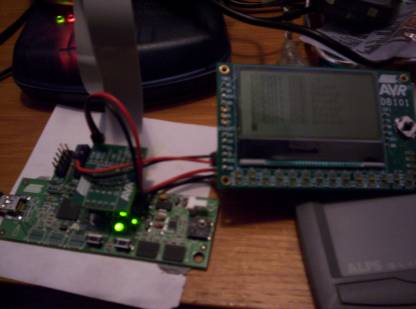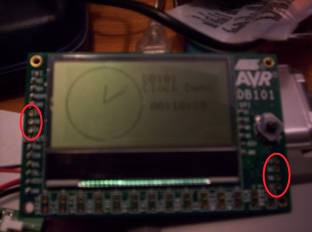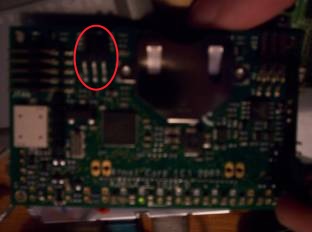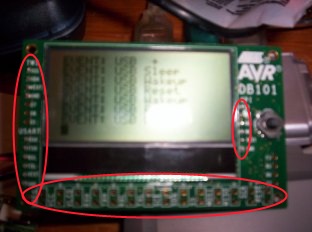DB101: Review
Well, today marks the day I can finally talk about my new toy, the DB101 board from Atmel. As it’s just become public today I thought I’d post a review here.

First off, a note: my board and its firmware is not the final revisions, so there may be a few slight differences in what I say and show here and what ships from Atmel. My board is missing the RGB backlight, so other than commenting that it exists on the final version there’s not much I can say about it.
The DB101 is designed to be a “human interface board”, and so despite being quite well powered it lacks a large selection of external general IO pins. This is by design – the board is supposed to be connected to a “master” board, and communicate via one of the on-board protocols such as serial or SPI. There are still seven completely free IOs for use however, available via two groups of small unfitted pads on the board shown below:

The available general IOs are F3, B5, B6, C2, D7, D6, and D5.
The board dimensions are quite small, at only 8cm x 5cm. This board however packs quite a punch, with a beefy MEGA1281 AVR microcontroller and a nice 128×64 pixel monochrome graphic display with RGB backlight. Despite the lack of a backlight on my test model, the display is still quite readable under most sane lighting conditions.
The DB101 has many similarities with the Butterfly board, also from Atmel – I consider this to be its “bigger brother”. Like the Butterfly it has an onboard Piezo speaker (for feedback beeps and bloops), dataflash (16Mbit) and joystick. It also, like its little predecessor, sports a coin battery which can power the board via an on-board buck-boost converter.
The coin battery is a nice addition for portable use, however it’s a little misleading. The battery can power the board, but the results are that the converter drains the entire battery in only a few short hours. On the incomplete model I have, the DB101 managed to completely discharge the coin battery while in sleep mode in firmware after slightly less than two days. For this reason, when not in use the battery should be removed or the board changed over to external power to preserve its lifespan (note this is unsuitable for applications using a RTC, where the power must be applied at all times).
Thankfully, the DB101 has an external power option. This power can be any voltage between 1.8V and 5.5V, which makes it more tolerant than the Butterfly. Vext can be fed into the board via any of the Vext pads next to the communication interface pads on the front of the board. To change between the two power sources, a jumper must be changed on the back of the board to isolate a supply – see below pictures.

The board is clocked via a 7.37MHz ceramic resonator, stuck on the back near the MEGA1281 AVR chip. This value is good for a multitude of error-free serial baudrates. For RTC applications, there is the standard 32.768KHz watch crystal attached to one of the AVR’s timers.
Programming and on-chip debugging of the board is made very simple with a couple of right-angled pin headers on the back of the DB101 for JTAG and ISP. Note that due to the size of the flash in the MEGA1281 (128KB), the Atmel Dragon development board is unable to JTAG-debug the DB101, however the full JTAG MKII will of course be able to do the job.
On the sides of the board are connectors for the USART, SPI and I2C interfaces. These are all level converted automatically, via the Vext pins when running of the DB101’s coin battery. The interface connectors are also duplicated along the bottom of the board, for easy layout of matching connectors on a master board.

That’s just about it. It’s a nice board and comes with a neat set of applications (slideshow, “Snake”, “Game of Life”, a serial terminal, etc.) and sure to become a fun toy amongst AVR developers in no time.


